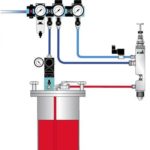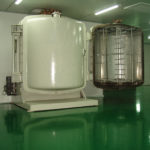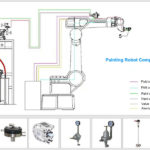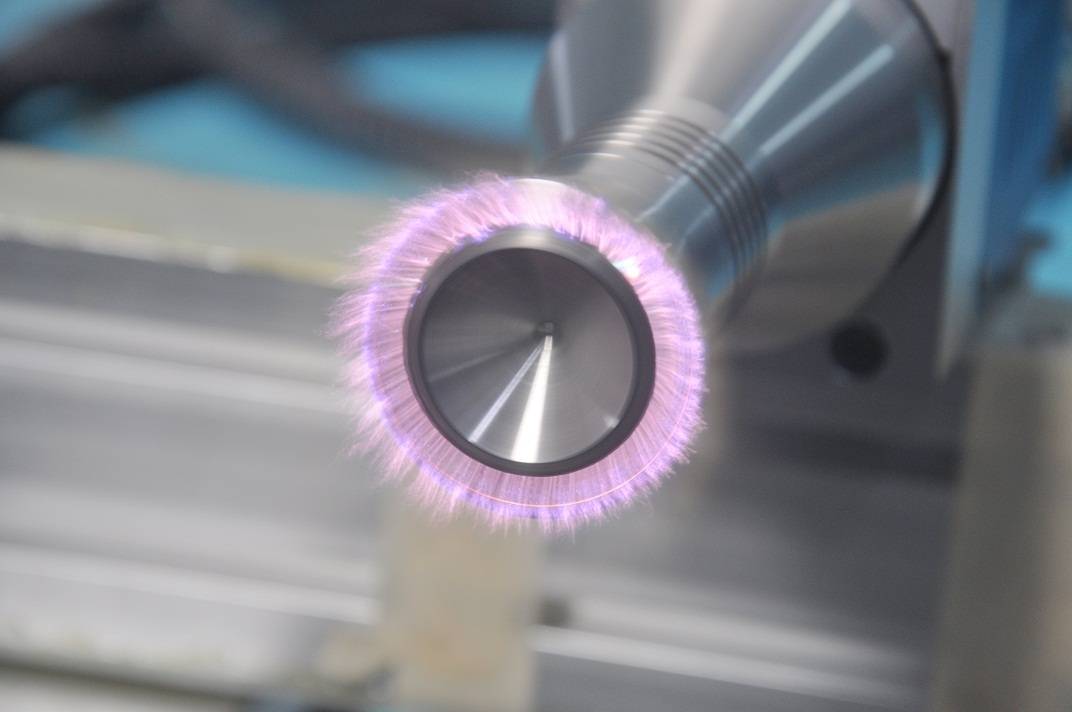
Plasma surface activation is a widely used technology in materials science and engineering, and its main role is to change the material surface properties through plasma treatment, so as to improve its adhesion, wettability, wear resistance and corrosion resistance. With the help of plasma surface treatment before spraying: remove various impurities (such as oil stains, rust, floating ash, old paint layer, etc.) adhered to the surface of the object, and give excellent substrates suitable for spraying standards to ensure that the coating has excellent corrosion resistance, decorative performance and some special effects. Thus plasma treatment on the object surface is crucial for high end spray painting.
Plasma Activation Principle
The plasma used in the process is a positively charged gas that contains many particles such as electrons, ions, free radicals, and excited molecules. Comparing to normal gas, it is in a high-energy state that is highly excited. When these plasmas come into contact with the material surface, they will cause the breaking of the chemical bonds on the surface and produce new reactive substances, thereby changing the structure and chemical properties of the surface, increasing the affinity between the surface layer and the paint, thereby improving the adhesion of the paint film.
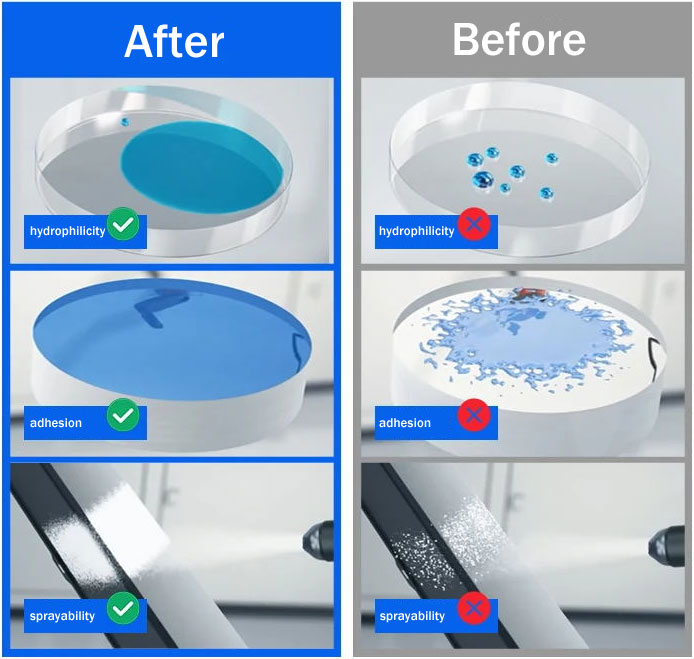 Mechanisms
Mechanisms
There are two main aspects involved in the mechanism: chemical reactions and physical effects. Chemical reaction refers to the reaction between the plasma and the chemical composition on the material surface to form a new compound or physisorption layer. Physical effects refer to the effects of plasma on the physical structure of the material surface, such as surface roughness, surface tension, etc
1. Chemical Reaction Cleaning: Chemical reaction with highly reactive free radicals in plasma and organic matter on the material surface, also known as PE. Oxygen cleaning is used to turn non-volatile organic compounds into volatile forms and produce carbon dioxide. Carbon monoxide and water. The advantage of chemical cleaning is the high cleaning speed. It is selective and more effective for cleaning organic contaminants, but the main disadvantage is that the oxides produced may form again on the material surface. Oxides are the least desirable in the wire bonding process, and these drawbacks can be avoided with appropriate process parameters
2. Physical Reaction Cleaning: Pure physical impact using ions in the plasma to remove atoms attached to the surface of the material, also known as sputter corrosion (SPE). Argon is used for cleaning, and argon blasts the surface of the device with enough energy to remove any dirt. The macromolecular chemical bonds in the polymer are separated into small molecules, evaporated, and discharged by a vacuum pump
Application
This technology has been widely used in the field of materials science and engineering, mainly including the following aspects:
- Enhancement of material adhesion: Through surface activation treatment, the adhesion ability of the material surface can be greatly improved, thereby enhancing its adhesion performance.
- Improvement of surface wettability: It can make the surface of the material easier to be wetted by liquid, so as to improve its fluidity and reaction rate.
- Improvement of wear resistance and corrosion resistance of materials: The wear resistance and corrosion resistance of materials can be improved by changing the chemical structure and physical form of the surface of materials
- Application in the manufacture of electronic devices: It can be used to clean the surface of electronic devices such as semiconductors and photovoltaic cells to improve the efficiency and life of the device.
- Applications in the biomedical field: It can be used to prepare biomedical materials such as biosensors, biochips and artificial blood vessels, so as to improve their biocompatibility and biological activity.
As a very promising new material surface treatment technology, plasma surface activation has a wide range of application prospects in many fields
Plasma surface activator
The atmospheric plasma activator is composed of a plasma generator, a gas delivery system, a pressure protection system and a plasma spray nozzle. The plasma generator generates high-pressure and high-frequency energy to ionize the air in the glow discharge that is activated and controlled in the nozzle steel tube, resulting in a low-temperature plasma, with the help of compressed air to spray the plasma to the surface of the workpiece, when the plasma meets the surface of the treated object, a series of chemical reactions and physical changes are generated, the surface is cleaned, and the hydrocarbon dirt, such as grease, auxiliary additives, etc., is removed, and the surface molecular chain structure is changed according to the material composition.
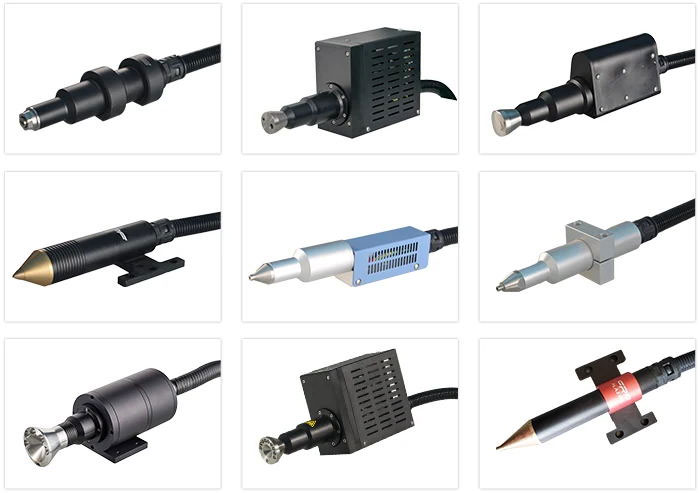 Free radical groups such as hydroxyl and carbon groups have been established, which have a role in promoting the adhesion of various coating materials and are optimized for bonding and paint applications. Under the same effect, a very thin high-tensile coated surface can be obtained by treating the surface with plasma, without the need for any other mechanical or chemical treatment to increase the adhesion.
Free radical groups such as hydroxyl and carbon groups have been established, which have a role in promoting the adhesion of various coating materials and are optimized for bonding and paint applications. Under the same effect, a very thin high-tensile coated surface can be obtained by treating the surface with plasma, without the need for any other mechanical or chemical treatment to increase the adhesion.
Through low-temperature plasma surface treatment, a variety of physical and chemical changes occur on the surface of the material, or etch and roughen, or form a dense cross-linked layer, or introduce oxygen-containing polar groups, so that the hydrophilicity, cohesiveness, dyeability, biocompatibility and electrical properties are improved. The surface of the material is treated under suitable process conditions, so that the surface morphology of the material has undergone significant changes, and a variety of oxygen-containing groups are introduced, so that the surface changes from non-polar and difficult-to-stick to a certain polarity, easy adhesion and hydrophilicity, which is conducive to bonding, coating and printing.

